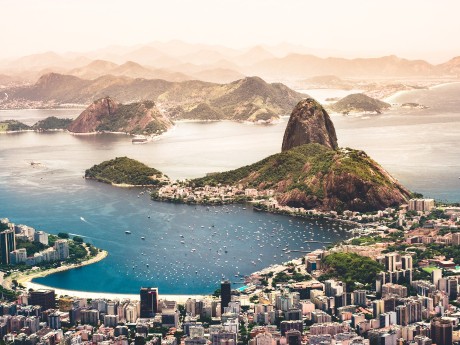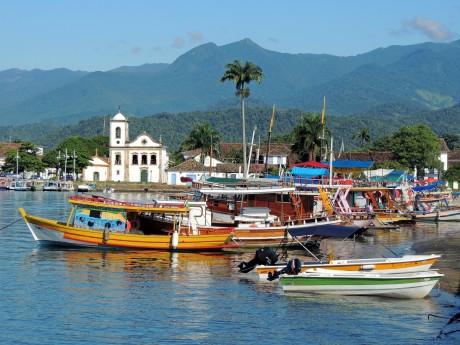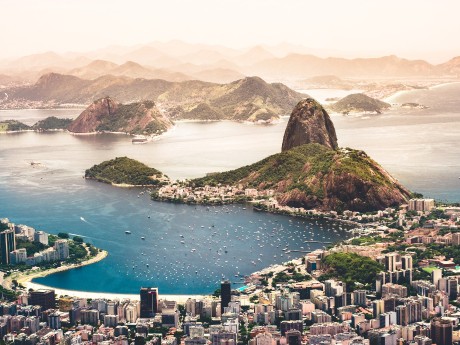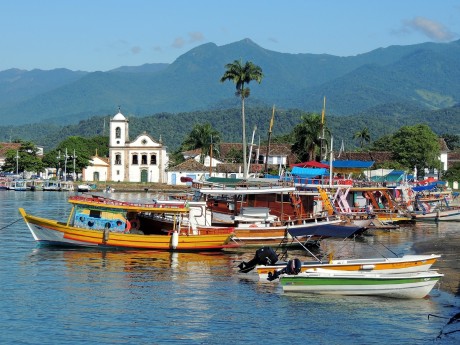Brazil: Rio de Janeiro & Paraty
Escape to the vibrant heart of Brazil with an unforgettable journey to Rio de Janeiro and Paraty. Starting in the vibrant city of Rio de Janeiro, visit the awe-inspiring Christ the Redeemer statue atop Mount Corcovado, offering unparalleled panoramic views. Explore the innovative Museu do Amanhã, seamlessly blending science and innovative design to focus on a sustainable future. Wander through the enchanting Escadaria Selarón, a mesmerizing mosaic-covered staircase renowned for its beauty.
Read more
Escape to the vibrant heart of Brazil with an unforgettable journey to Rio de Janeiro and Paraty. Starting in the vibrant city of Rio de Janeiro, visit the awe-inspiring Christ the Redeemer statue atop Mount Corcovado, offering unparalleled panoramic views. Explore the innovative Museu do Amanhã, seamlessly blending science and innovative design to focus on a sustainable future. Wander through the enchanting Escadaria Selarón, a mesmerizing mosaic-covered staircase renowned for its beauty. Rent a car and continue your adventure to the enchanting Paraty, where cobblestone streets wind through colonial architecture against a backdrop of lush mountains and pristine beaches. Immerse yourself in history as you explore well-preserved 17th-century buildings and churches, while also enjoying the vibrant arts scene with local galleries and festivals. Don't miss the chance to sail through Paraty Bay's crystalline waters, exploring secluded islands and pristine beaches, or trekking through the lush Atlantic Forest to discover hidden waterfalls and breathtaking viewpoints. Waterviews strives to offer accommodation options within walking distance of water and/or in an area of touristic interest. Our prices include taxes (but excludes local tourist taxes). Customize your trip to your personal preferences with optional activities (hit the “Add Activities’’) or change hotels, etc. Contact us for customization at no extra cost at: Service@waterviewstravel.com
Destinations
- Rio de Janeiro
- Paraty
- Rio de Janeiro
Itinerary
Rio de Janeiro

Rio de Janeiro is a must see on any trip to Brazil, and is a city that truly offers something for everyone. Visit the towering Christ the Redeemer statue and enjoy views over the city’s picturesque coastline, spend days relaxing on the sands of Copacabana or Ipanema or head to one of Rio's excellent museums, the choice is all yours. By night, the Lapa district comes alive with bustling samba bars and local eateries, and those who want a real taste of Brazil’s vibrant culture can’t miss the city's annual carnival.
Read more
Rio de Janeiro is a must see on any trip to Brazil, and is a city that truly offers something for everyone. Visit the towering Christ the Redeemer statue and enjoy views over the city’s picturesque coastline, spend days relaxing on the sands of Copacabana or Ipanema or head to one of Rio's excellent museums, the choice is all yours. By night, the Lapa district comes alive with bustling samba bars and local eateries, and those who want a real taste of Brazil’s vibrant culture can’t miss the city's annual carnival.
Additional Information
It is a common mistake to think of Rio as Brazil's capital, a distinction it lost on April 21, 1960 when Brasilia became the capital. Beaches such as Copacabana and Ipanema, the Christ The Redeemer (Cristo Redentor) statue, the stadium of Maracanã and Sugarloaf Mountain (Pão de Açúcar) are all well-known sights of what the inhabitants call the "marvelous city" (cidade maravilhosa), and are also among the first images to pop up in travelers´ minds, along with the Carnaval celebration.
The South Zone holds most of Rio's landmarks and world-famous beaches, in an area of only 43.87 km² (17 sq miles). Many of them are within walking distance of each other (for instance, the Sugarloaf lies about 8 km (5 miles) from Copacabana beach). Most hotels and hostels are located in this part of the city, which is compressed between the Tijuca Range (Maciço da Tijuca) and the sea. There are important places in other regions as well, such as Maracanã stadium in the North Zone and the many fascinating buildings in the Centre.
Sadly, most people also know Rio for its violence and crime, especially related to drugs. And social problems, as slums or favelas, areas of poor-quality housing and living; these slums are usually located on the city's many mountain slopes, juxtaposed with middle-class neighbourhoods.
History
Rio was founded in 1565 by the Portuguese as a fortification against French privateers who trafficked wood and goods from Brazil. Piracy played a major role in the city's history, and there are still colonial fortresses to be visited (check below). The Portuguese fought the French for nearly 10 years, both sides having rival native tribes as allies. For the next two centuries it was an unimportant outpost of the Portuguese Empire, until gold, diamonds, and ore were found in Minas Gerais in 1720. Then, as the nearest port, Rio became the port for these minerals and replaced Salvador as the main city in the colony in 1763. When Napoleon invaded Portugal, the Royal Family moved to Brazil and made Rio capital of the Kingdom (so it was the only city outside Europe to be capital of a European country). When Brazil became independent in 1822, it adopted Monarchy as its form of government (with Emperors Pedro I and Pedro II). Many historians and Brazilians from other places say cariocas are nostalgic of the Royal and Imperial times, which is reflected in many place names and shop names. In 2009, the city won their bid to host the games of the XXXI Olympics in the summer of 2016. This was the fifth bid by the city, whose 1936, 1940, 2004, and 2012 bids lost.
Climate
The climate of the city of Rio de Janeiro is semi-humid tropical. According to the amount of rainfall, there are two seasons: a hot and rainy season, which runs from September to April, and a dry season, which runs from June to August. The amount of rainfall per year is approximately 1200 mm (47.2 inches), raining about 90 days per year. The city usually receives about 2080 hours of sunshine a year. In December and January, the heat and humidity are usually constant, reaching up to 40º C (104º F), but even with the rains, this season is the high tourist season. During winter in the southern hemisphere, temperatures in Rio are usually milder, rainfall decreases, and average temperatures are typically 19° C (66° F) to maximums of 25° C (77° F).
© Sourced from Wikivoyage
Paraty

Backed by the lush mountains of the Mata Atlântica and filled with a rich heritage, the picturesque town of Paraty is one of Brazil’s architectural gems. The highlight here is undoubtedly the town’s historic centre, its cobblestone streets lined with colourful colonial-era buildings and local craft shops that lead to a picturesque harbour from where you can take scenic boat rides. Nearby, explore some of the region’s most idyllic nature, where pristine islands, beaches and waterfalls await.
Read more
Backed by the lush mountains of the Mata Atlântica and filled with a rich heritage, the picturesque town of Paraty is one of Brazil’s architectural gems. The highlight here is undoubtedly the town’s historic centre, its cobblestone streets lined with colourful colonial-era buildings and local craft shops that lead to a picturesque harbour from where you can take scenic boat rides. Nearby, explore some of the region’s most idyllic nature, where pristine islands, beaches and waterfalls await.
Additional Information
Paraty grew in the 18th century as a strategically important port for exporting the gold mined in Minas Gerais. When shipments in nearby Rio began to attract the attention and ambition of pirates and privateers from rival European powers, the Portuguese began using Paraty as their safe port for getting their gold to Lisbon. Together with Ouro Preto, the town was part of the Estrada Real (Caminho Real or Caminho do Ouro, Gold Road), a route used to export gold in colonial times. It was also an obligatory sleep-over stop for travelers between Rio and São Paulo until the late 1800s, when the inner road was opened. This caused Paraty to be forgotten, stalled in time, away from "progress" and disfiguration and helped it preserve its old city as it was in the past. In the 1970s, it was rediscovered as a popular tourist destination.
© Sourced from Wikivoyage
Rio de Janeiro

Rio de Janeiro is a must see on any trip to Brazil, and is a city that truly offers something for everyone. Visit the towering Christ the Redeemer statue and enjoy views over the city’s picturesque coastline, spend days relaxing on the sands of Copacabana or Ipanema or head to one of Rio's excellent museums, the choice is all yours. By night, the Lapa district comes alive with bustling samba bars and local eateries, and those who want a real taste of Brazil’s vibrant culture can’t miss the city's annual carnival.
Read more
Rio de Janeiro is a must see on any trip to Brazil, and is a city that truly offers something for everyone. Visit the towering Christ the Redeemer statue and enjoy views over the city’s picturesque coastline, spend days relaxing on the sands of Copacabana or Ipanema or head to one of Rio's excellent museums, the choice is all yours. By night, the Lapa district comes alive with bustling samba bars and local eateries, and those who want a real taste of Brazil’s vibrant culture can’t miss the city's annual carnival.
Additional Information
It is a common mistake to think of Rio as Brazil's capital, a distinction it lost on April 21, 1960 when Brasilia became the capital. Beaches such as Copacabana and Ipanema, the Christ The Redeemer (Cristo Redentor) statue, the stadium of Maracanã and Sugarloaf Mountain (Pão de Açúcar) are all well-known sights of what the inhabitants call the "marvelous city" (cidade maravilhosa), and are also among the first images to pop up in travelers´ minds, along with the Carnaval celebration.
The South Zone holds most of Rio's landmarks and world-famous beaches, in an area of only 43.87 km² (17 sq miles). Many of them are within walking distance of each other (for instance, the Sugarloaf lies about 8 km (5 miles) from Copacabana beach). Most hotels and hostels are located in this part of the city, which is compressed between the Tijuca Range (Maciço da Tijuca) and the sea. There are important places in other regions as well, such as Maracanã stadium in the North Zone and the many fascinating buildings in the Centre.
Sadly, most people also know Rio for its violence and crime, especially related to drugs. And social problems, as slums or favelas, areas of poor-quality housing and living; these slums are usually located on the city's many mountain slopes, juxtaposed with middle-class neighbourhoods.
History
Rio was founded in 1565 by the Portuguese as a fortification against French privateers who trafficked wood and goods from Brazil. Piracy played a major role in the city's history, and there are still colonial fortresses to be visited (check below). The Portuguese fought the French for nearly 10 years, both sides having rival native tribes as allies. For the next two centuries it was an unimportant outpost of the Portuguese Empire, until gold, diamonds, and ore were found in Minas Gerais in 1720. Then, as the nearest port, Rio became the port for these minerals and replaced Salvador as the main city in the colony in 1763. When Napoleon invaded Portugal, the Royal Family moved to Brazil and made Rio capital of the Kingdom (so it was the only city outside Europe to be capital of a European country). When Brazil became independent in 1822, it adopted Monarchy as its form of government (with Emperors Pedro I and Pedro II). Many historians and Brazilians from other places say cariocas are nostalgic of the Royal and Imperial times, which is reflected in many place names and shop names. In 2009, the city won their bid to host the games of the XXXI Olympics in the summer of 2016. This was the fifth bid by the city, whose 1936, 1940, 2004, and 2012 bids lost.
Climate
The climate of the city of Rio de Janeiro is semi-humid tropical. According to the amount of rainfall, there are two seasons: a hot and rainy season, which runs from September to April, and a dry season, which runs from June to August. The amount of rainfall per year is approximately 1200 mm (47.2 inches), raining about 90 days per year. The city usually receives about 2080 hours of sunshine a year. In December and January, the heat and humidity are usually constant, reaching up to 40º C (104º F), but even with the rains, this season is the high tourist season. During winter in the southern hemisphere, temperatures in Rio are usually milder, rainfall decreases, and average temperatures are typically 19° C (66° F) to maximums of 25° C (77° F).
© Sourced from Wikivoyage





